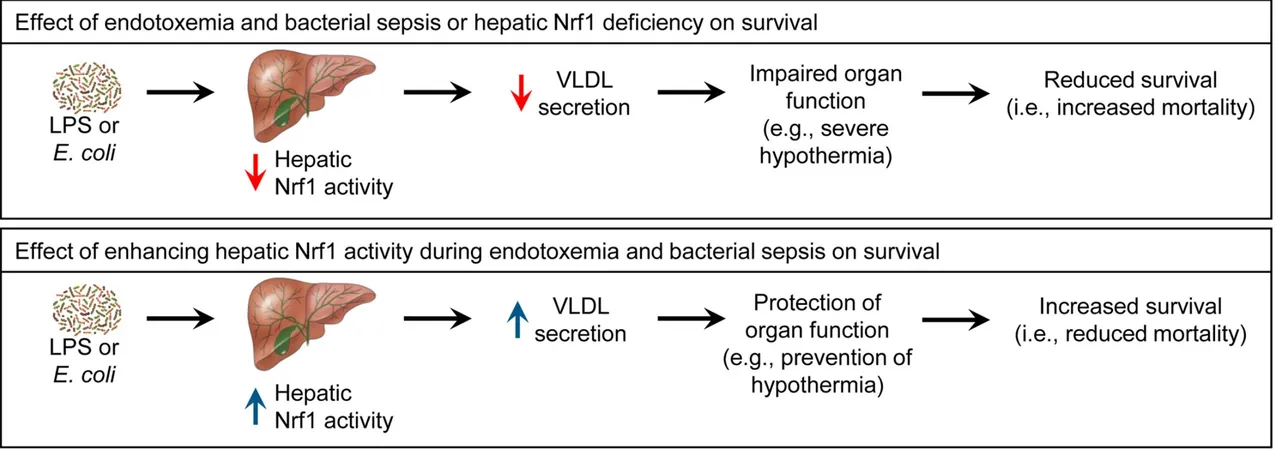
Breakthrough Discovery: New Way to Combat Deadly Sepsis
2025-09-15
Author: Amelia
A Groundbreaking Advancement in Sepsis Research
In a remarkable breakthrough, researchers from the University of Saskatchewan (USask) have unveiled a novel strategy to enhance the human body's defenses against sepsis, a critical and often fatal condition triggered by the immune system's exaggerated reaction to infections.
Sepsis: The Unseen Killer in Hospitals
Sepsis stands as the leading cause of mortality in intensive care units across the globe, posing a significant challenge for healthcare professionals and scientists alike. Its potential to inflict severe organ damage—affecting the heart, kidneys, lungs, and liver—makes understanding and combating it imperative.
The Protein That Could Change Everything
Dr. Scott Widenmaier, an associate professor at USask, has focused his research on a specific protein that holds promise in the battle against sepsis. By manipulating this protein, his team aims to unveil a new protective pathway for patients.
Understanding Sepsis: It’s Not Just the Invasion
Contrary to common belief, severe illness from sepsis isn't merely due to the invading bacteria or virus. Instead, it’s the body’s mismanaged immune response that often escalates to sepsis. Widenmaier describes this as a "dysregulated immune response," which can lead to life-threatening complications.
A New Focus on Disease Tolerance
Traditional sepsis treatments have primarily targeted infections. However, recent research has highlighted a critical aspect: the body possesses a built-in mechanism of disease tolerance that can be optimized to mitigate damage during infections.
The Discovery of NRF1: A Potential Game Changer
Widenmaier and his team have identified NRF1, a transcription factor protein in the liver, acting as a vital "molecular switch" for disease tolerance. In experimental E. coli infections, over-expressing NRF1 significantly improved responses to the infection and offered protection from sepsis.
This protein enhances the liver's production of very low-density lipoprotein (VLDL), a particle that aids in shielding organs from the ravages of sepsis. Widenmaier believes leveraging this connection could radically improve outcomes for sepsis patients.
Next Steps in Sepsis Treatment Research
The future of this research lies in exploring the feasibility of targeting NRF1 for treatment and understanding its effectiveness in patients commonly facing sepsis. Though human trials are not yet on the horizon, Widenmaier is eager to dive deeper into this promising field.
"We aim to explore this extensively," he stated, expressing optimism about collaborating with clinical investigators across the country to advance the science behind sepsis care.









 Brasil (PT)
Brasil (PT)
 Canada (EN)
Canada (EN)
 Chile (ES)
Chile (ES)
 Česko (CS)
Česko (CS)
 대한민국 (KO)
대한민국 (KO)
 España (ES)
España (ES)
 France (FR)
France (FR)
 Hong Kong (EN)
Hong Kong (EN)
 Italia (IT)
Italia (IT)
 日本 (JA)
日本 (JA)
 Magyarország (HU)
Magyarország (HU)
 Norge (NO)
Norge (NO)
 Polska (PL)
Polska (PL)
 Schweiz (DE)
Schweiz (DE)
 Singapore (EN)
Singapore (EN)
 Sverige (SV)
Sverige (SV)
 Suomi (FI)
Suomi (FI)
 Türkiye (TR)
Türkiye (TR)
 الإمارات العربية المتحدة (AR)
الإمارات العربية المتحدة (AR)